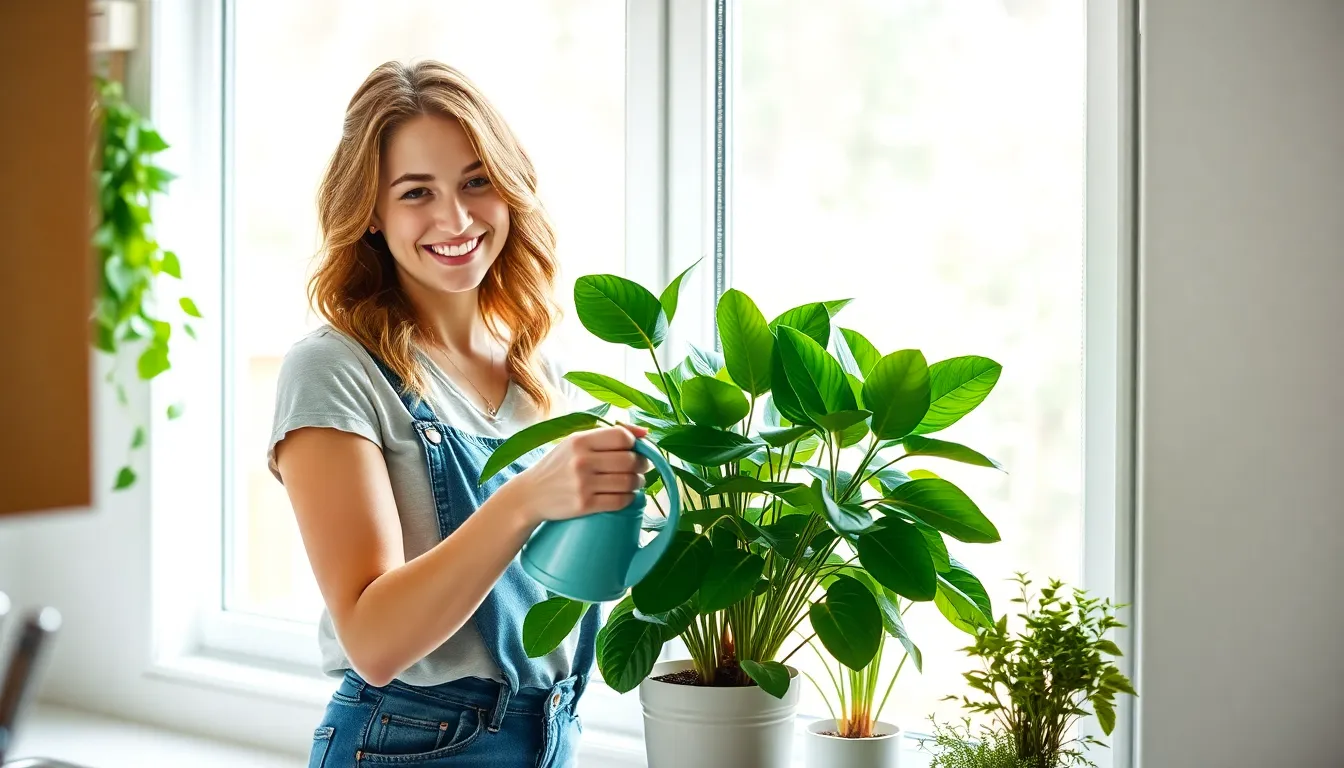Have you ever dreamed of growing your own coffee right at home? Coffee plants make stunning houseplants with their glossy green leaves and potential to produce the very beans that could one day become your morning brew.
Taking care of a coffee plant isn’t as daunting as it might seem. Whether you’re a seasoned plant parent or just beginning your indoor gardening journey, understanding the basics of coffee plant care—from proper watering and lighting to soil requirements and pruning techniques—will help your plant thrive. With the right attention, your coffee plant can become a beautiful, long-lasting addition to your indoor garden.
Understanding the Coffee Plant
Coffee plants belong to the Rubiaceae family, with Coffea arabica and Coffea canephora (robusta) being the most commonly cultivated species. These evergreen perennials aren’t just sources of your favorite morning beverage—they’re also attractive houseplants with glossy, dark green leaves and a compact growth habit that fits beautifully into home environments.
Types of Coffee Plants for Home Growing
Coffea arabica ranks as the most popular choice for home growers due to its manageable size and superior flavor profile. This variety typically grows 6-15 feet tall when mature but adapts well to container cultivation. Arabica plants produce beans with complex flavors, lower caffeine content, and subtle acidity that accounts for approximately 60% of global coffee production.
Coffea canephora (robusta) offers greater disease resistance and higher caffeine content than arabica varieties. These plants grow more vigorously, reaching heights of 15-20 feet in optimal conditions. Robusta thrives in warmer temperatures and produces beans with a stronger, more bitter taste often used in espresso blends and instant coffee.
For smaller spaces, dwarf coffee varieties like ‘Nana’ provide excellent alternatives. These compact plants grow only 3-4 feet tall, making them perfect for apartments or limited growing areas. Even though their smaller stature, they still produce beans and feature the same attractive foliage as their larger counterparts.
Natural Habitat and Growth Requirements
Coffee plants originate from the understory of Ethiopian highlands and tropical forests of Africa. This native environment shapes their preferred growing conditions: filtered sunlight, consistent moisture, and nutrient-rich soil with excellent drainage.
Temperature stability plays a crucial role in coffee plant health. These plants thrive in temperatures between 60-75°F (15-24°C) and suffer damage when exposed to temperatures below 55°F (13°C). Maintaining moderate humidity levels between 50-70% mimics their natural rainforest habitat and prevents leaf issues common in dry indoor environments.
The altitude factor significantly impacts coffee flavor development. In their natural habitat, arabica coffee grows at elevations between 2,000-6,500 feet (600-2,000 meters) above sea level, while robusta tolerates lower altitudes of 200-3,000 feet (60-900 meters). This elevation difference contributes to arabica’s more nuanced flavor profile compared to robusta’s robust characteristics.
Essential Light and Temperature Conditions
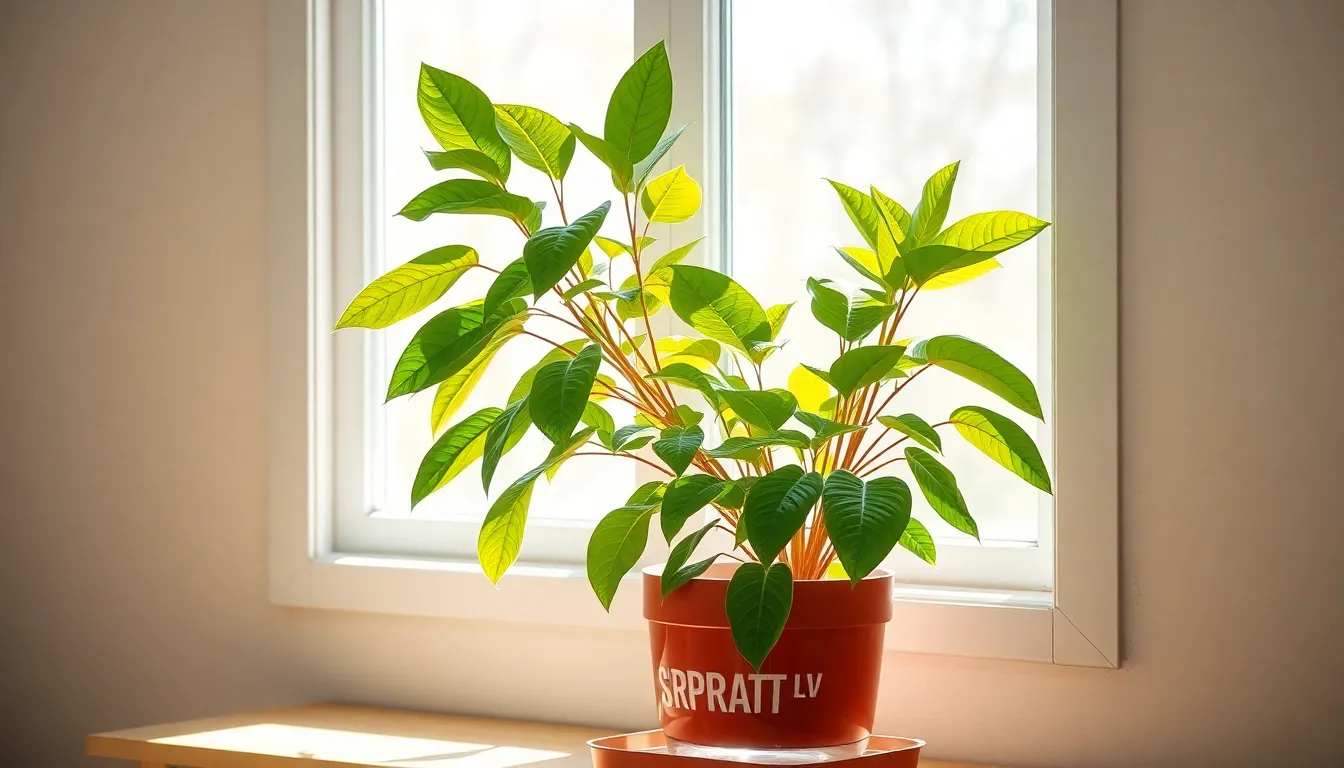
Coffee plants require exact environmental conditions to thrive indoors. Creating the right balance of light and temperature ensures your coffee plant remains healthy and potentially productive.
Optimal Sunlight Exposure
Coffee plants flourish in bright, indirect sunlight rather than direct exposure. Position your plant near a window that receives filtered light or gentle morning rays to mimic their natural understory habitat. Direct afternoon sun can scorch the delicate leaves, causing brown spots and curling. East-facing windows typically provide ideal morning light, while north-facing windows offer consistent indirect brightness throughout the day. If your space lacks sufficient natural light, supplementing with grow lights placed 12-24 inches away can provide the necessary illumination without damaging the foliage.
Temperature Range for Healthy Growth
Coffee plants perform best in temperatures between 65°F and 85°F (18°C to 29°C) during active growth periods. Maintaining consistent room temperatures around 65°F to 80°F creates an ideal growing environment for your indoor coffee plant. During winter, slightly cooler temperatures of 59°F to 64°F (15°C to 18°C) encourage bloom bud development, potentially leading to flowering and eventual fruiting. Protect your coffee plant from cold drafts, air conditioning vents, and heating elements that cause sudden temperature fluctuations. These temperature shifts can stress the plant, resulting in leaf drop and stunted growth. Coffee plants also appreciate humidity levels between 50-70%, reflecting their tropical origins. Placing a water tray near the plant or using a humidifier helps maintain the moisture they crave, especially in dry indoor environments.
Watering and Humidity Guidelines

Coffee plants require exact moisture conditions to thrive indoors. Maintaining the right balance of water and humidity mimics their native rainforest environment and encourages healthy growth.
Proper Watering Techniques
Coffee plants need consistent but careful watering to flourish. Water your plant when the top 1-2 inches of soil feel dry to the touch, rather than following a strict schedule. Thoroughly saturate the soil until excess water flows from the drainage holes, ensuring complete hydration. Empty any standing water from the saucer within a few minutes to prevent root rot, which coffee plants are particularly susceptible to developing. Yellowing leaves often indicate overwatering, while wilting or browning leaf edges suggest your plant is too dry. Adjusting your watering routine based on these visual cues helps maintain optimal soil moisture without risking root damage.
Creating the Right Humidity Environment
Coffee plants thrive in high humidity environments similar to their tropical origins. Maintain humidity levels above 50% for optimal growth and to prevent brown, crispy leaf edges. Daily misting provides a simple method to increase moisture around your plant’s foliage. For more consistent humidity, place your coffee plant on a pebble tray filled with water or use a room humidifier near the plant. Coffee plants perform best in temperatures between 65-80°F with consistent, indirect sunlight that complements their humidity needs. The combination of proper light, temperature, and humidity creates a microclimate that closely resembles the plant’s natural habitat, promoting healthy development and potentially encouraging flowering for those hoping to eventually harvest coffee beans.
Soil and Fertilization Requirements
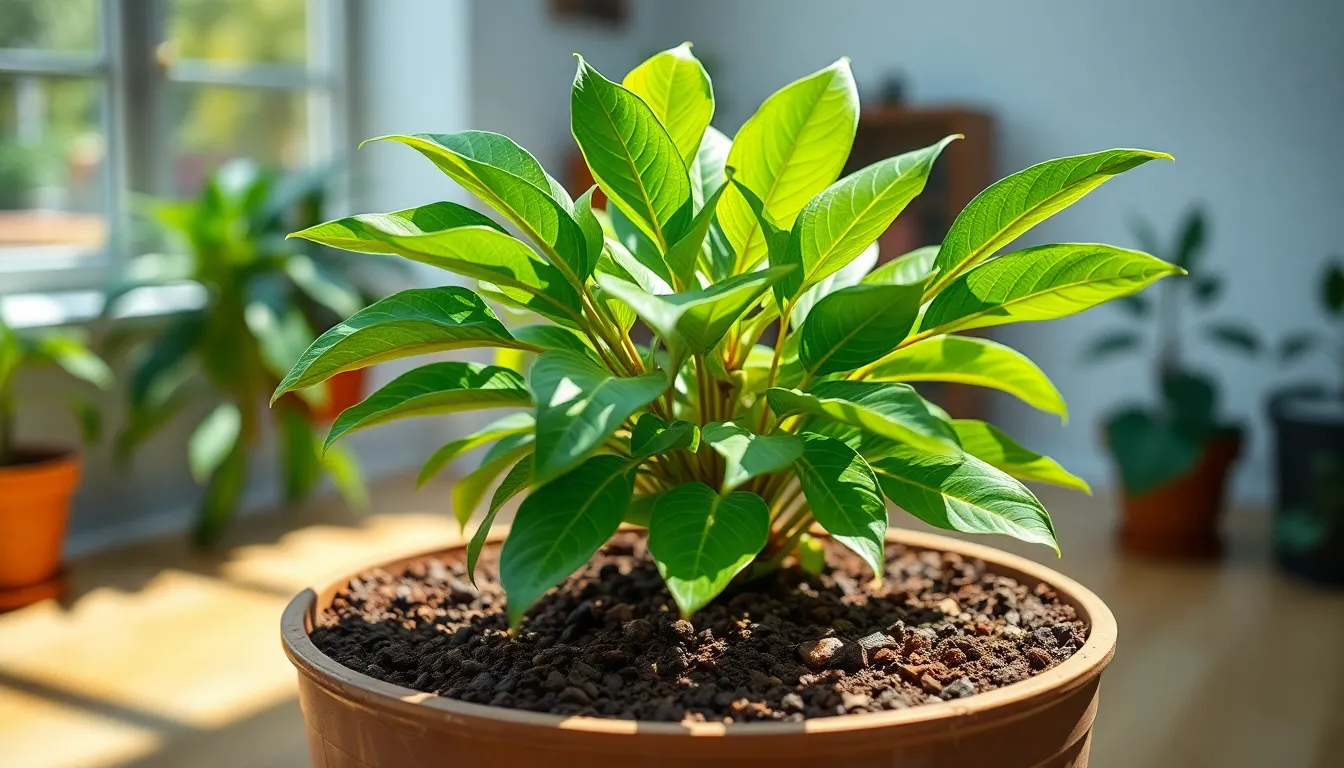
Creating the perfect soil environment for your coffee plant establishes the foundation for healthy growth and potential bean production. Coffee plants have exact soil and nutrient needs that mirror their native rainforest habitats.
Best Soil Composition for Coffee Plants
Coffee plants thrive in well-draining, loamy soils that prevent waterlogging while retaining adequate moisture. Volcanic soils rich in minerals like phosphorus and potassium provide the ideal growing medium for coffee plants, contributing significantly to their growth and bean development. The optimal pH range for coffee plants falls between 5.5 and 6.5, with Arabica varieties preferring slightly more acidic conditions (pH 5.5-6.0) compared to Robusta, which tolerates a broader pH range. A soil depth of at least one meter ensures adequate space for root development, allowing your coffee plant to establish a strong foundation for growth.
Fertilization Schedule and Types
Coffee plants require exact nutrients to support their various growth stages and eventual fruiting. Nitrogen promotes lush vegetative growth, while phosphorus supports robust root development and fruiting, and potassium enhances overall plant health and disease resistance. Apply a balanced fertilizer once monthly during active growth periods to maintain nutrient levels. Organic matter incorporation through mulching with coffee husks or leaves enriches the soil naturally, breaking down gradually to release essential nutrients. Your coffee plant benefits from consistent moisture levels in the soil without becoming waterlogged, which can lead to root diseases. Maintaining this balance between proper soil composition and strategic fertilization creates ideal growing conditions for your indoor coffee plant to flourish.
Pruning and Maintenance
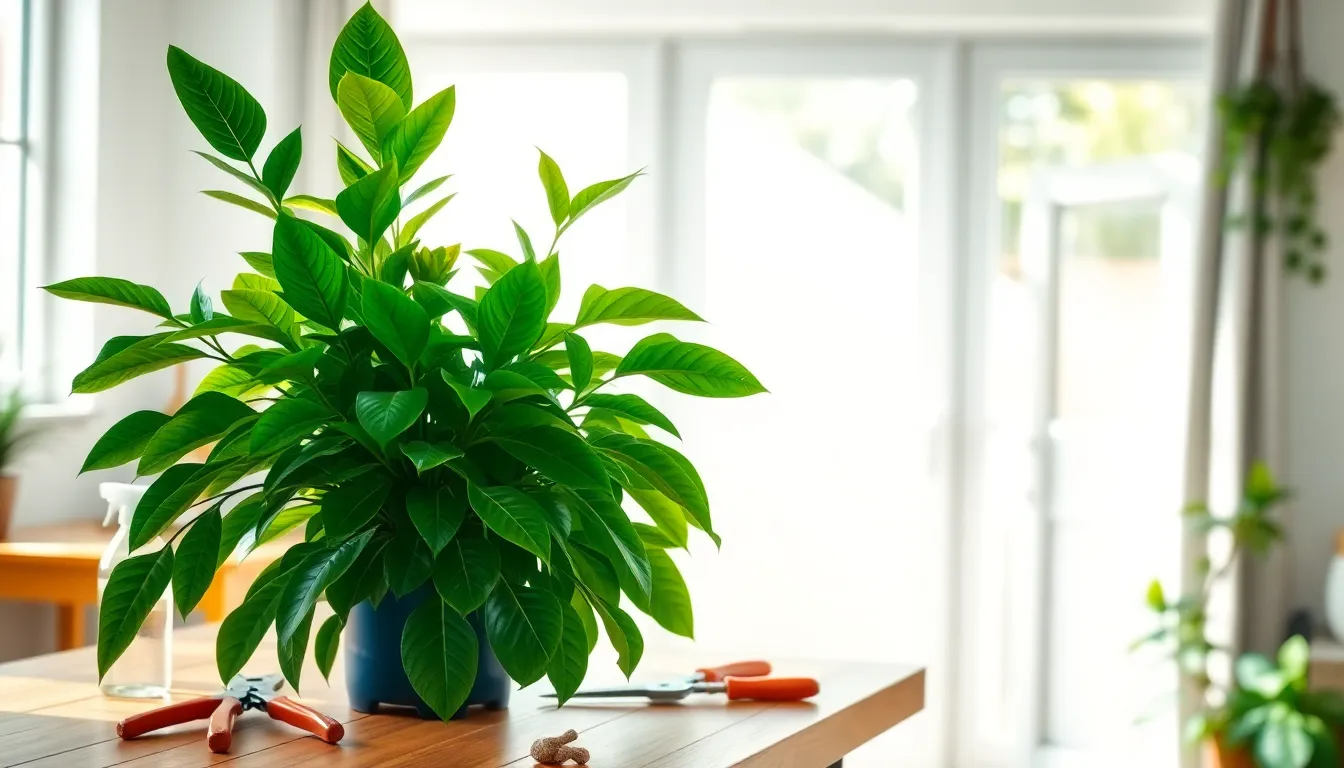
Coffee plants require minimal pruning compared to other houseplants but benefit greatly from occasional trimming to maintain their health and appearance. Regular maintenance keeps your coffee plant looking its best while promoting vigorous growth and preventing potential issues.
When and How to Prune Your Coffee Plant
Early spring marks the ideal time to prune your coffee plant as it enters its active growing season. Using clean, sharp pruning shears, trim leggy stems and remove any dead or weak branches to encourage a balanced shape and promote thicker, healthier growth. Focus on maintaining an open structure that allows light to reach the inner branches, improving overall photosynthesis efficiency. For taller specimens, cutting back the top helps control height and encourages bushier growth rather than a thin, stretched appearance. Light pruning improves air circulation throughout the plant, which plays a crucial role in preventing fungal diseases that thrive in stagnant conditions.
Managing Common Pests and Diseases
Coffee plants face several common pest challenges, including scale insects, mealybugs, and spider mites that can damage foliage and stunt growth. Regular inspection of leaves and stems helps catch infestations early, allowing for prompt treatment with insecticidal soap or neem oil applications. Fungal issues like leaf rust and root rot often result from overwatering or poor air circulation around the plant. To prevent these problems, allow the top 25% of soil to dry between waterings and ensure your pot has sufficient drainage holes to prevent water accumulation. Daily misting or using a humidifier maintains the 50-70% humidity levels coffee plants thrive in while keeping pests at bay. Avoiding harsh direct sunlight reduces plant stress, making your coffee plant naturally more resistant to both pests and diseases throughout its life cycle.
Repotting Your Coffee Plant
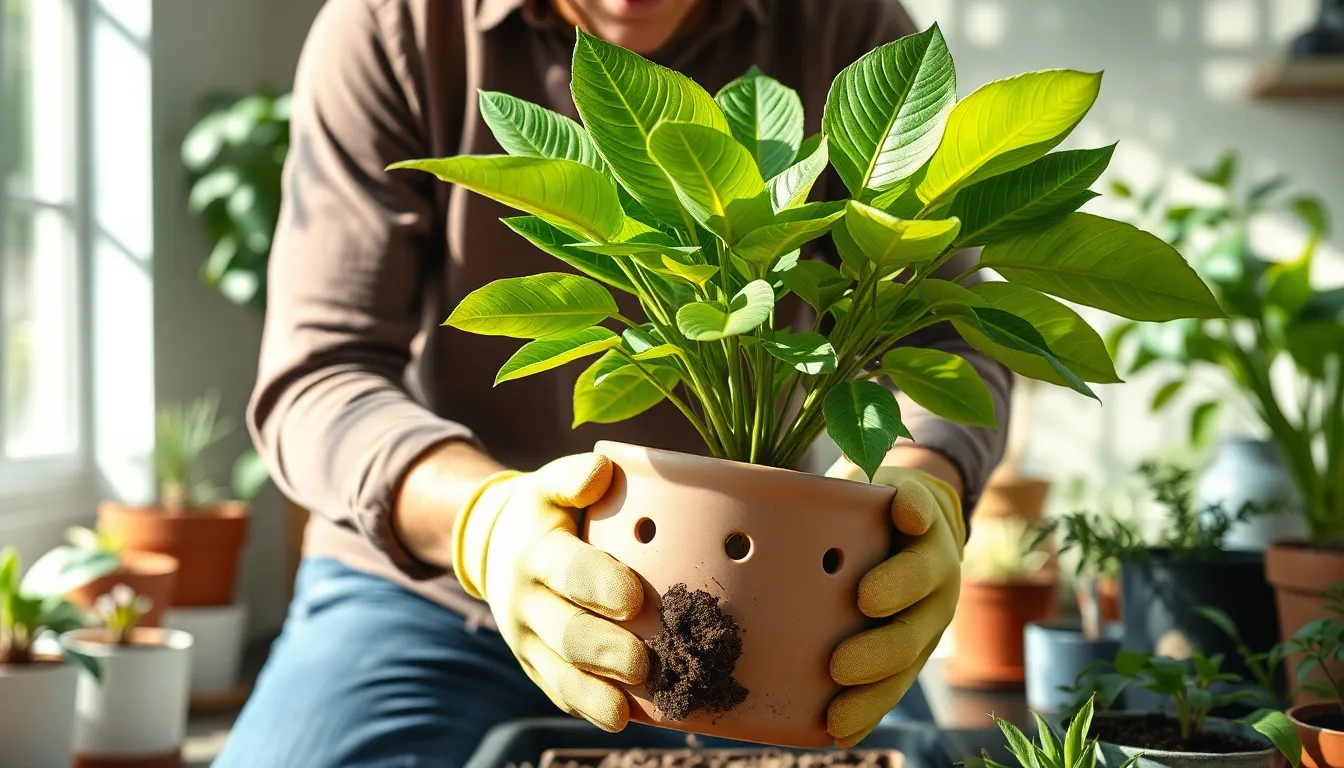
Repotting is a crucial aspect of coffee plant care that ensures continued growth and health. Your coffee plant’s container serves as its home, and occasionally, it needs a larger, refreshed space to thrive.
Signs It’s Time to Repot
Coffee plants communicate their need for a new pot through several clear signals. Roots emerging from drainage holes indicate your plant has become rootbound, with no more room to expand in its current container. Slower growth or yellowing leaves even though proper care often points to a plant that’s outgrown its pot and needs more space. The soil itself provides clues – if it’s compacted, drains poorly, or dries out too quickly, it’s likely exhausted and unable to support your coffee plant properly. Most coffee plants require repotting every 1-3 years, depending on their growth rate and container size.
Step-by-Step Repotting Process
Gathering the right supplies marks the first step in successful repotting. Select a pot one size larger than the current container, ensuring it has adequate drainage holes to prevent water buildup. Use a rich, peat-based potting mix that offers excellent drainage while retaining enough moisture for your coffee plant’s needs.
Water your plant lightly before beginning the repotting process. Moistening the soil helps the root ball release from the old pot and minimizes stress on the plant during transition.
Removing your coffee plant requires gentle handling to avoid damage. Hold the plant at the base of the stem, turn the pot sideways, and tap the container while carefully sliding the plant out. Never pull the plant by its stem or leaves, as this can cause irreparable damage.
Inspect the root system once it’s exposed and free from the old pot. Healthy roots appear firm and light-colored, while dark, mushy roots indicate potential rot issues. Gently loosen the root ball with your fingers if roots are densely matted or circling, creating small separations to encourage outward growth in the new pot.
Position your coffee plant in its new home by first adding a layer of fresh soil to the bottom of the pot. Center the plant, adjusting the height to ensure the top of the root ball sits about an inch below the pot’s rim. Fill in around the roots with fresh soil, pressing lightly to eliminate air pockets without compacting too firmly.
Water thoroughly after repotting to help soil settle and provide moisture to stressed roots. The water should flow freely through the drainage holes, indicating proper pot setup and soil structure.
Place your newly repotted coffee plant in bright, indirect light, avoiding direct sunlight and drafts that could further stress the recovering plant. Maintaining humidity around 50-70% during this transition period helps minimize shock – a pebble tray or humidifier works perfectly for this purpose.
Monitor your coffee plant closely for the first few weeks after repotting. It’s normal for plants to show minor signs of stress such as slight leaf droop, but they typically recover within 2-3 weeks as they adjust to their new container. Resume regular care once your plant shows signs of stability, including your normal watering routine when the top half-inch of soil feels dry.
Harvesting Coffee Beans at Home
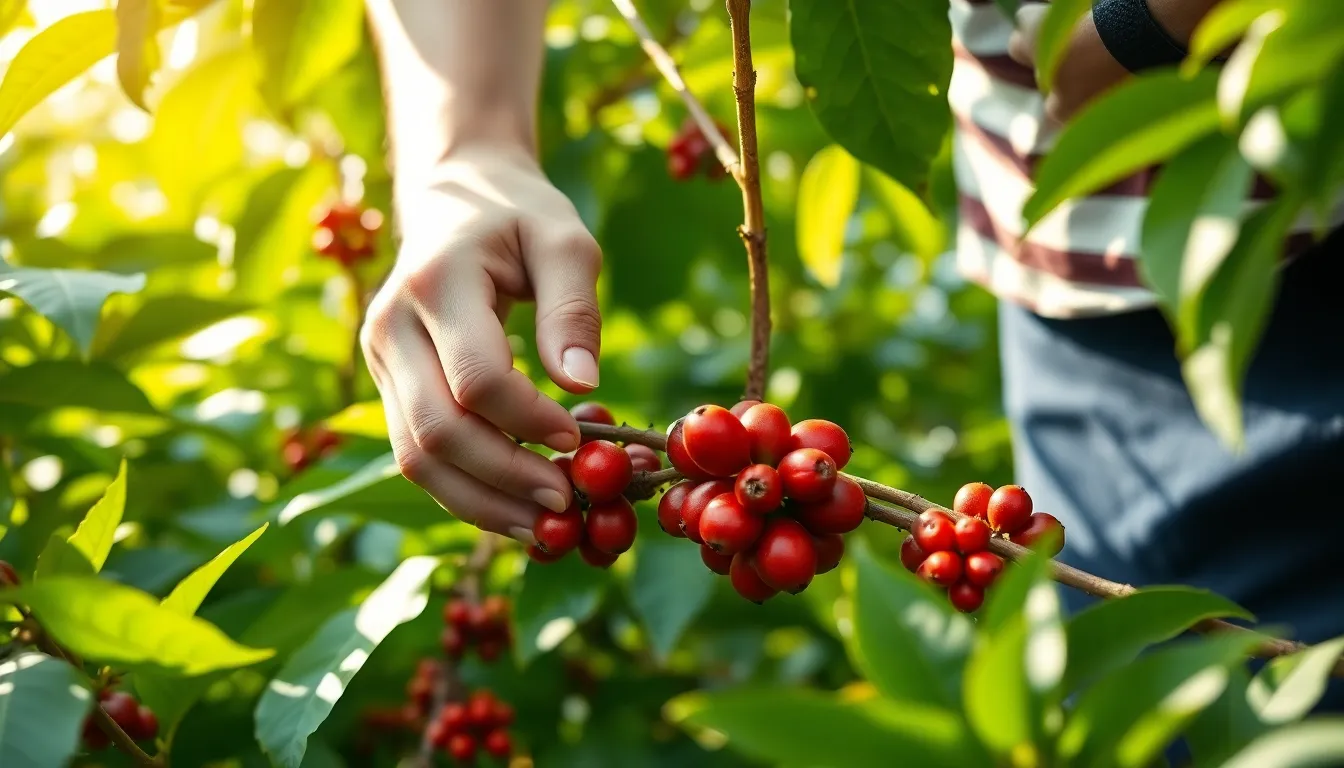
Growing your own coffee beans offers an incredibly rewarding experience for coffee enthusiasts who’ve nurtured their plants from seedlings to maturity. The journey from flower to bean requires patience, but the satisfaction of brewing coffee from your own harvest makes the effort worthwhile.
When to Harvest
Coffee cherries reach their peak ripeness when they transform from green to a vibrant red color. This color change signals that the beans inside have developed their full flavor profile and are ready for picking. Typically, cherries mature several months after the white, jasmine-scented flowers appear on your plant. Each cherry contains two coffee beans nestled inside the fruit pulp. For indoor plants, you might notice that cherries ripen at different rates, so selective picking ensures you’re only harvesting the perfectly ripe fruits for optimal flavor.
Processing Home-Grown Coffee Beans
Processing home-grown coffee transforms fresh cherries into brewable beans through several essential steps. First, hand-pick only the ripe red cherries from your plant, leaving any green ones to continue developing. Next, remove the outer skin and pulp through pulping—this can be done manually by gently squeezing the cherries to release the beans inside.
After pulping, fermentation begins by soaking the beans in water for 12-48 hours, breaking down the sticky mucilage layer surrounding the beans. Once fermentation completes, thoroughly rinse the beans to remove any remaining residue before spreading them out to dry in a warm, well-ventilated area. The drying process continues until the beans reach approximately 11-12% moisture content, which typically takes 1-2 weeks depending on your climate.
When the beans are completely dry, remove the thin parchment layer (hulling) to reveal the green coffee beans inside. Finally, roast these green beans to your preferred darkness level to develop their distinctive flavors and aromas. Each of these processing steps influences the final taste of your coffee, allowing you to experiment with different techniques to create your perfect cup.
Troubleshooting Common Coffee Plant Problems

Even well-cared-for coffee plants occasionally develop issues that require attention. Identifying and addressing problems early helps maintain plant health and prevents minor issues from becoming serious setbacks.
Addressing Leaf Issues
Coffee plant leaves communicate health problems through visual cues. Yellowing leaves typically indicate overwatering or poor drainage, leading to root rot – adjust your watering schedule and ensure soil drains properly. Brown leaf tips signal low humidity levels or excessive direct sunlight, requiring increased moisture in the air and relocation to a spot with bright, indirect light.
Leaf drop occurs when plants experience sudden temperature fluctuations or drafts, so maintain a stable environment protected from cold air currents. Regular inspection for pests like spider mites and mealybugs is essential – these tiny invaders appear on leaf undersides and stem joints. Treat any infestations promptly with insecticidal soap or neem oil applications to prevent spreading.
Resolving Growth Problems
Leggy or spindly growth in coffee plants signals insufficient light exposure or lack of proper pruning. Move your plant to a brighter location with indirect sunlight and trim back elongated stems to encourage bushier, more compact growth patterns. Slow growth rates often stem from nutrient deficiencies or inappropriate watering practices – carry out a regular fertilization schedule during growing seasons and monitor soil moisture consistently.
Flowering issues frequently relate to inadequate temperature variations between seasons. Coffee plants benefit from a cooler winter resting period between 59°F and 64°F (15°C to 18°C) to stimulate bud development and subsequent blooming. Creating this temperature differential mimics natural growing conditions and encourages the reproductive cycle to progress normally.
Conclusion
Growing your own coffee plant at home brings both beauty and the unique satisfaction of potentially harvesting your own beans. With the right care routine focused on proper light exposure humidity management and well-draining soil your coffee plant can thrive for years to come.
Remember that patience plays a key role in coffee cultivation. By addressing issues promptly adjusting seasonal care and providing consistent attention you’ll develop a deeper connection with this fascinating plant.
Whether you’re drawn to coffee plants for their glossy foliage ornamental value or the exciting possibility of home-grown coffee the journey is rewarding. With these care guidelines you’re well-equipped to nurture a healthy vibrant coffee plant that becomes a prized addition to your indoor garden.
Frequently Asked Questions
Can coffee plants really grow indoors?
Yes, coffee plants can thrive as indoor houseplants with proper care. They adapt well to indoor environments when given filtered sunlight, consistent moisture, and adequate humidity levels. While they may take several years to produce beans, they offer attractive foliage as houseplants even if they never flower or fruit.
How much light does a coffee plant need?
Coffee plants need bright, indirect sunlight. Position them near east or west-facing windows where they can receive filtered light throughout the day. Avoid direct afternoon sun which can scorch leaves. In low-light conditions, consider supplementing with grow lights to ensure healthy growth and prevent leggy stems.
How often should I water my coffee plant?
Water your coffee plant when the top 1-2 inches of soil feel dry to the touch. Coffee plants prefer consistent moisture but are susceptible to root rot if overwatered. Typically, this means watering once a week, adjusting based on your home’s conditions. Yellowing leaves often indicate overwatering, while wilting suggests underwatering.
What type of soil is best for coffee plants?
Coffee plants thrive in well-draining, slightly acidic soil with a pH between 5.5 and 6.5. Use a loamy mix rich in organic matter, combining potting soil, perlite, and compost or worm castings. This provides both the drainage and nutrient retention coffee plants need to develop healthy root systems.
How do I increase humidity for my coffee plant?
Create higher humidity by misting the plant daily, placing it on a pebble tray filled with water, grouping it with other plants, or using a humidifier nearby. Coffee plants prefer humidity levels between 50-70%. In particularly dry environments, a humidifier offers the most consistent solution for maintaining optimal moisture levels.
When should I repot my coffee plant?
Repot your coffee plant every 2-3 years or when you notice roots emerging from drainage holes, slowed growth, or quickly drying soil. Spring is the ideal time for repotting. Choose a container 1-2 inches larger than the current pot, use fresh soil, and handle the root ball gently to minimize transplant shock.
Can I harvest coffee beans from my indoor plant?
Yes, indoor coffee plants can produce beans, but they typically need 3-5 years to mature before flowering. Plants need proper pollination to develop cherries, which take 7-9 months to ripen from green to red. While indoor plants may produce smaller yields, home-harvested beans can be processed and roasted for a truly homegrown cup of coffee.
Why are my coffee plant’s leaves turning yellow?
Yellowing leaves usually indicate overwatering or poor drainage. Check soil moisture and ensure your pot has adequate drainage holes. Other causes include nutrient deficiencies, pest infestations, or insufficient light. Adjust your care routine by allowing soil to dry slightly between waterings and providing balanced fertilizer during growing seasons.
Do coffee plants need fertilizer?
Yes, coffee plants benefit from regular fertilization during the growing season (spring through fall). Apply a balanced, water-soluble fertilizer diluted to half-strength monthly, or use a slow-release fertilizer every three months. During winter, reduce or eliminate fertilizing to match the plant’s slower growth rate.
How tall will an indoor coffee plant grow?
Indoor coffee plants typically reach 3-6 feet in height when mature, though they can be maintained smaller through regular pruning. Dwarf varieties like ‘Nana’ stay naturally more compact at 1-2 feet tall. Growth rate depends on environmental conditions, with optimal care resulting in 1-2 feet of growth annually until maturity.

